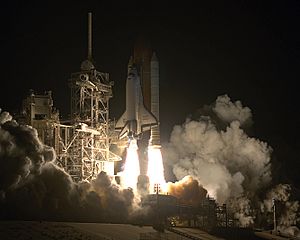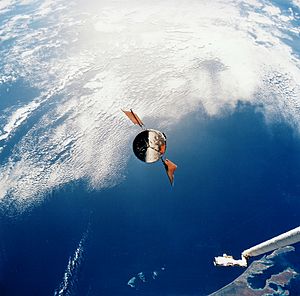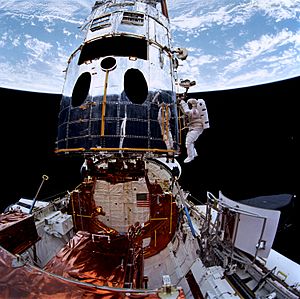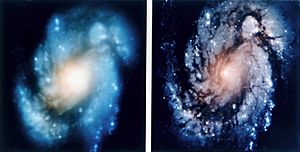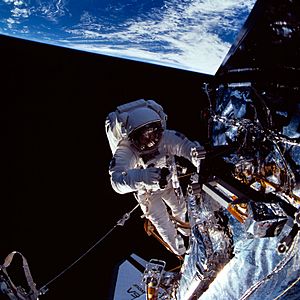STS-61 facts for kids
STS-61 was a very important space mission by NASA to fix the Hubble Space Telescope. It was the fifth flight of the Space Shuttle Endeavour. The mission started on December 2, 1993, from Kennedy Space Center in Florida.
The Hubble Space Telescope had a problem with its main mirror, which made its images blurry. This mission fixed that! Astronauts installed a new main camera and a special lens system called COSTAR. This made Hubble's vision clear, more than three and a half years after it was launched. The mission also gave Hubble new solar panels and other upgrades.
Because there was so much work to do, STS-61 was one of the most complicated Space Shuttle missions ever. It lasted almost 11 days. The astronauts did five spacewalks, which was a record at the time! Two different pairs of astronauts took turns doing the spacewalks so they wouldn't get too tired. During the flight, astronaut Jeffrey A. Hoffman even spun a dreidel for the holiday of Hanukkah for people watching on TV.
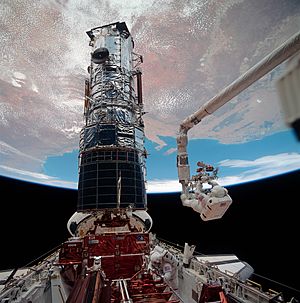
Musgrave being raised to the top of Hubble by Canadarm, as it sits in Endeavour's payload bay.
|
|
| Names | Space Transportation System-59 |
|---|---|
| Mission type | First Hubble Space Telescope servicing |
| Operator | NASA |
| Mission duration | 10 days, 19 hours, 58 minutes, 33 seconds (achieved) |
| Distance travelled | 7,135,464 km (4,433,772 mi) |
| Orbits completed | 163 |
| Spacecraft properties | |
| Spacecraft | Space Shuttle Endeavour |
| Launch mass | 113,541 kg (250,315 lb) |
| Landing mass | 94,972 kg (209,377 lb) |
| Payload mass | 8,011 kg (17,661 lb) |
| Crew | |
| Crew size | 7 |
| Members |
|
| Start of mission | |
| Launch date | 2 December 1993, 09:27:00 UTC |
| Rocket | Space Shuttle Endeavour |
| Launch site | Kennedy Space Center, LC-39B |
| Contractor | Rockwell International |
| End of mission | |
| Landing date | 13 December 1993, 05:25:33 UTC |
| Landing site | Kennedy Space Center, SLF Runway 33 |
| Orbital parameters | |
| Reference system | Geocentric orbit |
| Regime | Low Earth orbit |
| Perigee | 291 km (181 mi) |
| Apogee | 576 km (358 mi) |
| Inclination | 28.45° |
| Period | 93.30 minutes |
| Capture of Hubble Space Telescope | |
| RMS capture | 4 December 1993, 08:48 UTC |
| Berthing date | 4 December 1993, 09:26 UTC |
| RMS release | 9 December 1993, 10:26 UTC |
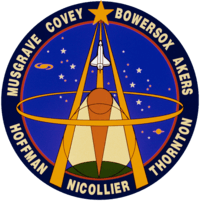 STS-61 mission patch 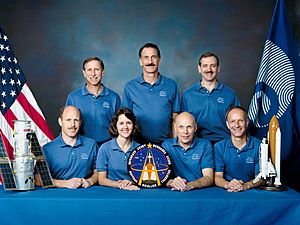 Standing: Richard O. Covey, Jeffrey A. Hoffman, Thomas D. Akers Seated: Kenneth D. Bowersox, Kathryn C. Thornton, F. Story Musgrave, Claude Nicollier |
|
Contents
Meet the Crew
| Position | Astronaut | |
|---|---|---|
| Commander | Fourth and last spaceflight |
|
| Pilot | Second spaceflight |
|
| Mission Specialist 1 | Third spaceflight |
|
| Mission Specialist 2 | Second spaceflight |
|
| Mission Specialist 3 | Fourth spaceflight |
|
| Mission Specialist 4 | Fifth spaceflight |
|
| Mission Specialist 5 | Third spaceflight |
|
Spacewalks (EVAs)
A spacewalk, also called an Extravehicular Activity (EVA), is when an astronaut leaves their spacecraft and floats in space.
- Musgrave and Hoffman – EVA 1
- Start: December 5, 1993 – 03:44 UTC
- End: December 5, 1993 – 11:38 UTC
- Duration: 7 hours, 54 minutes
- Thornton and Akers – EVA 2
- Start: December 6, 1993 – 03:29 UTC
- End: December 6, 1993 – 10:05 UTC
- Duration: 6 hours, 36 minutes
- Musgrave and Hoffman – EVA 3
- Start: December 7, 1993 – 03:35 UTC
- End: December 7, 1993 – 10:22 UTC
- Duration: 6 hours, 47 minutes
- Thornton and Akers – EVA 4
- Start: December 8, 1993 – 03:13 UTC
- End: December 8, 1993 – 10:03 UTC
- Duration: 6 hours, 50 minutes
- Musgrave and Hoffman – EVA 5
- Start: December 9, 1993 – 03:30 UTC
- End: December 9, 1993 – 10:51 UTC
- Duration: 7 hours, 21 minutes
Mission Story
Launch Day
The Space Shuttle Endeavour launched successfully on December 2, 1993. The launch had been delayed by one day because of bad weather. After launch, the astronauts checked all the shuttle's systems and got ready for the busy days ahead.
Chasing Hubble
On the second day, Endeavour started catching up to the Hubble Space Telescope. The crew checked the robot arm, called the Canadarm, and their spacesuits. Everything was working perfectly.
Catching the Telescope
On the third day, astronaut Jeffrey A. Hoffman spotted Hubble using binoculars. He noticed that one of Hubble's large solar panels was bent at a 90-degree angle. These panels, which are 12 m (39 ft) long, were supposed to be replaced anyway because they wobbled a lot.
Commander Dick Covey carefully guided Endeavour closer to Hubble. Then, astronaut Claude Nicollier used the shuttle's robot arm to grab the telescope. This happened when the shuttle was flying over the south Pacific Ocean. Nicollier then gently placed Hubble into the shuttle's cargo bay.
Spacewalk 1: Fixing Hubble's Gyros
Story Musgrave and Jeffrey A. Hoffman began the first spacewalk. They started by getting their tools and safety gear ready. Hoffman then attached himself to the end of the robot arm, which Nicollier controlled from inside the shuttle.
Musgrave and Hoffman's main job was to replace two Rate Sensing Units (RSUs). These units contain gyroscopes, which are like compasses that help Hubble point in the right direction. They had a bit of trouble with the doors that covered the gyros, but they worked together to get them latched.
This spacewalk lasted 7 hours and 50 minutes, which was one of the longest spacewalks in NASA history at that time.
Spacewalk 2: New Solar Panels
Astronauts Thomas D. Akers and Kathryn C. Thornton performed the second spacewalk. Their main task was to replace Hubble's old solar panels with new ones. These panels provide power to the telescope.
Thornton had a small problem with her spacesuit's communication system, but the crew found a way to work around it. Akers and Thornton carefully removed the damaged solar panel and gently threw it away into space. Then, they installed a new, working solar panel. After that, they replaced the second solar panel.
Spacewalk 3: A New Camera
The third spacewalk was done by Musgrave and Hoffman again. Their most important job was to replace Hubble's main camera, called the Wide Field and Planetary Camera (WF/PC). They carefully removed the old camera and then installed the new, improved Wide Field and Planetary Camera 2 (WFPC2). This new camera had its own system to fix the blurry vision problem.
After installing the camera, Hoffman also replaced two magnetometers on Hubble. These are like the telescope's "compass" and help it know its position relative to Earth's magnetic field.
Spacewalk 4: The COSTAR Fix
Thornton and Akers carried out the fourth spacewalk. Their main goal was to install the Corrective Optics Space Telescope Axial Replacement (COSTAR) system. This special system was designed to fix Hubble's blurry vision for all the other instruments, besides the new WFPC2 camera.
They successfully removed an old instrument and put COSTAR in its place. They also upgraded Hubble's onboard computer by adding more memory and a special co-processor. This spacewalk was a complete success.
Spacewalk 5: Final Touches
Musgrave and Hoffman did the fifth and final spacewalk. They replaced the electronics that control the solar panels. The solar panels didn't want to deploy at first, but the astronauts were able to crank them open by hand.
They also installed some covers on the magnetometers to protect them. During this spacewalk, astronaut Hoffman spun a dreidel for Hanukkah for everyone to see.
Releasing Hubble and Landing
After all the repairs were done, the team checked Hubble's systems one last time. There was a small concern about one of Hubble's data units, but controllers decided it was safe to release the telescope.
Claude Nicollier used the Canadarm to lift Hubble out of the shuttle's cargo bay. Hubble's main door, which covers its giant mirror, was opened. Then, the telescope was released back into space. Commander Dick Covey and pilot Kenneth D. Bowersox gently moved Endeavour away from Hubble.
The Space Shuttle Endeavour landed safely at Kennedy Space Center on December 13, 1993. The mission was a huge success, giving the Hubble Space Telescope clear vision to explore the universe!
Images for kids
-
Standing: Richard O. Covey, Jeffrey A. Hoffman, Thomas D. Akers
Seated: Kenneth D. Bowersox, Kathryn C. Thornton, F. Story Musgrave, Claude Nicollier
See also
 In Spanish: SM1 para niños
In Spanish: SM1 para niños


